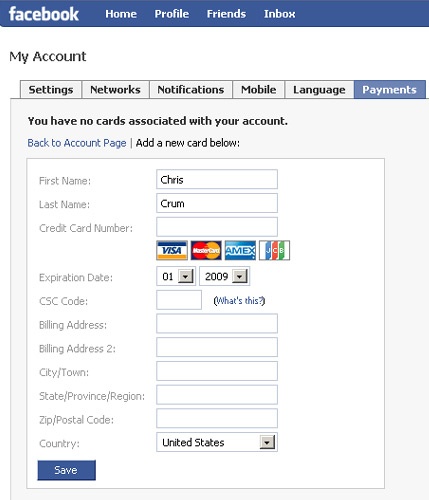페플-알고리즘
facebook 개발 2010. 9. 9. 18:03 |작년에 구글의 페이먼트 플랫폼에 대한 언급을 한 적이 있다.
구글 플랫폼 안에 커머스 플랫폼이 잠재하고 있다.

올해는 페이스북이 페이먼트 플랫폼을 시작한 것 같다. 페이스북이 구글 체크아웃을 기획한 Prashant Fuloria를 스카웃한 것은 의미심장하다. 아직은 테스트 단계이긴 하나 Pay with Facebook 기능이 작동하고 있다는 것은 페이스북이 구글에 이어 페이먼트 플랫폼을 구축하게 되었음을 의미한다.
Facebook Meets Google Checkout

Common Business Models for Facebook Applications에 보면 아래와 같이 나와 있다. 소셜 미디어의 수익모델이 어떻게 구성되어 있는지 잘 볼 수 있다. 눈에 띄는 것은 Virtual Credits / Virtual Goods이다. 비실물 상품의 유통과 비실물 상품의 결제를 위한 가상 통화에 대해 페이스북이 신경을 많이 쓰고 있다는 것을 알 수 있다. 이미 페이스북에는 무수히 많은 3rd party application이 들어와 있는데 이 중의 상당수가 게임이다. 게임 개발자가 아이템을 엔드 유저에게 직접 판매할 때, 엔드 유저가 Facebook Credit로 결제하는 모습은 앞으로 매우 자연스럽게 확산될 것으로 보인다.
Advertising
We at Facebook have had success serving targeted advertisements to our users based on information we know about them. By leveraging the data we give you access to (as detailed in our Developer Terms of Service) and data users share with you directly as a part of your application experience, you can serve highly relevant ads within the canvas page. You can find more specific details about what is and isn't appropriate in our Platform Principles and Policies and Statement of Rights and Responsibilities.
A key thing to think about is: what makes your app unique? Why are users using your app? For example, Movies (by Flixster) shows trailers and serves ads related to upcoming movies. iLike, a music app, serves targeted ads based on musicians that the users have indicated they like, as well as their location. Many game apps serve targeted ads focused primarily on gamers.
And don't feel like you need to do this all by yourself--there are a number of external parties who run ad networks specifically for social applications – learn more about them here.
"Freemium" (or Subscription)Once you've created a solid core experience, think about additional features you can create that your users would like. For example, Playfish's Who Has the Biggest Brain? makes its core functionality available to all users, but users can choose to "Go Pro!" for a one-time fee and access additional fresh content, such as more games, time trials, and more. Think about what additional content you can create that some users may want to pay for. And be sure you keep innovating – don't do something that's just a quick win, keep users coming back again and again. There are a number of ways that people are currently accepting payments on Facebook. Learn more here about some of the available providers.
Virtual Credits / Virtual GoodsAnother interesting way that developers are monetizing their applications is by enabling users to purchase or earn virtual credits within their applications and then providing ways that users can redeem them for virtual goods or game play. Texas HoldEm Poker (by Zynga) gives users a small amount of "Chips" to encourage Poker play, and then monetizes by having users buy additional "Chips" in order to continue playing. (We're not the legal experts, but we're told that this is not considered gambling because the users can never cash out their Chips for actual currency. Needless to say—you are responsible for working through those legal issues for your applications… ) Applications like (fluff) Friends allow users to earn one kind of credit ("Munny") and purchase another kind ("Gold") for access to premium virtual goods.
See more experts speak about their experiences with virtual goods in the online videos from the 2008 Virtual Goods Summit. (link: http://vgsummit2008.com/video/)
Also, instead of accepting payments directly from users for subscriptions or virtual goods, some applications instead allow users to complete affiliate offers by filling out surveys or agreeing to try new products. There are a number of providers who consolidate these types of offers, see more about them here.
Affiliate FeesIf your application is related to things that users are already accustomed to paying for (books, DVDs, movie tickets, music, or clothing, to name a few) then you may be able to successfully charge a fee for helping those users locate those goods. For example, book applications like Visual Bookshelf help users identify books they may want to purchase (by surfacing social information like what their friends have read, reviewed, and recommended), and then receive an affiliate fee from Amazon for books referred through that application. Travel applications can likewise accept affiliate fees.
MerchandisingHave a brand that users love? Help them share their love while off Facebook – with t-shirts, stickers, mugs, hats – and let them show their love for your brand proudly.
2년 전에 구글 vs 이베이 vs 마이스페이스/유튜브 포스트에서 아래와 같은 그림을 그린 적이 있다. Search player인 구글이 체크아웃이란 페이먼트 플랫폼을 구축했고, Social platform인 페이스북이 페이먼트 플랫폼을 구축하게 되니 Commerce platform을 갖고 있는 이베이, 아마존은 양면 공격을 받고 있는 셈이다. 특히 이베이의 경우, Paypal 비즈니스의 직접적인 경쟁상대가 구글 체크아웃 말고도 페이스북이 하나 더 추가된 셈이다.
아래 URL을 보면 재미있는 얘기가 나온다. 페이스북에 온라인 상점을 만들 수 있게 해주는 서비스이다. 결제는 페이팔을 통해 할 수 있도록 한다고 한다.
http://www.insidefacebook.com/2009/10/26/payvment-plans-payment-app-for-facebook-pages/
페이스북에서 구동되는 외부 애플리케이션 유형이 다변화되면서 급기야는 EC 호스팅 기능까지 들어왔다. 페이스북이 EC 호스팅을 호스팅하는 형국인 것이다. 이거 원 페이스북판 씁쓸한 인생이당~ ^^ 유상무상무~
구글의 페이먼트 플랫폼보다 페이스북의 페이먼트 플랫폼이 더 무섭게 느껴진다. 이미 거대한 규모의 엔드 유저 회원 DB를 확보하고 있고, 수십 만개의 3rd party application이 페이스북으로 물밀듯이 들어오고 있는 상황에서 페이스북이 페이먼트 플랫폼을 정식으로 오픈하고 드라이브를 걸게 되면 볼만한 광경이 연출될 것 같다. 페이스북 플랫폼, 페이스북의 페이먼트 플랫폼.. 중요한 관찰 포인트이다. ^^
 |
PS. 관련 포스트
구글 플랫폼 안에 커머스 플랫폼이 잠재하고 있다.
구글 vs 이베이 vs 마이스페이스/유튜브 = Search vs Commerce vs Social/Entertainment
http://www.socialtimes.com/2009/10/the-future-of-social-media-monetization-part-1/
http://www.socialtimes.com/2009/10/the-future-of-social-media-monetization-part-ii/
http://www.techcrunch.com/2009/10/14/payvment-enables-retail-storefronts-on-facebook-via-paypals-adaptive-payments-api/

